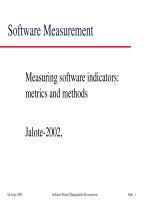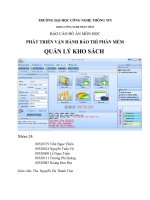PHÁT TRIỂN VẬN HÀNH BẢO TRÌ PHẦN MỀM - Chương 5: pot
Bạn đang xem bản rút gọn của tài liệu. Xem và tải ngay bản đầy đủ của tài liệu tại đây (251.48 KB, 24 trang )
1
UIT-VNUHCM 2009
PHÁT TRIỂN VẬN HÀNH BẢO
TRÌ PHẦN MỀM
ThS. NGUYỄN THỊ THANH TRÚC
TRƯỜNG ĐẠI HỌC CÔNG NGHỆ THÔNG TIN
KHOA CÔNG NGHỆ PHẦN MỀM
2
UIT-VNUHCM 2009
Company Logo
Nội dung (Chương 5)
Thảo luận và làm bài tập
TIN
KiỂM THỬ
TÍNH DÙNG LẠI VÀ KHẢ NĂNG DÙNG LẠI
3
UIT-VNUHCM 2009
Chương 4:
KHẢ NĂNG SỬ DỤNG LẠI VÀ KiỂM THỬ
5.1 TÍNH DÙNG LẠI VÀ KHẢ NĂNG DÙNG LẠI
5.2 KiỂM THỬ
4
UIT-VNUHCM 2009
KHẢ NĂNG SỬ DỤNG LẠI VÀ KiỂM THỬ
TÍNH DÙNG LẠI VÀ KHẢ NĂNG DÙNG LẠI
o
Giới thiệu
o
Định nghĩaDefinitions
o
Mục đích của việc sử dụng lại
o
Mục tiêu và lợi ích của việc dùng lại
o
Hướng tiếp cận của dùng lại
o
Phân tích phạm vi
o
Công nghệ cấu phần
o
Mô hình qui trình dùng lại
o
Các yếu tố tác động lên việc sử dụng lại
KiỂM THỬ
o
Giới thiệu
o
Định nghĩa
o
Tại sao kiểm thử phần mềm
o
Công việc của người kiểm thử phần mềm
o
Kiểm thử gì và như thế nào
o
Phân loại kiểm thử
o
Thẩm định và đánh giá
o
Kế hoạch kiểm thử
5
UIT-VNUHCM 2009
5.1 TÍNH DÙNG LẠI VÀ KHẢ NĂNG DÙNG LẠI
Giới thiệu
Định nghĩa
Mục đích của việc sử dụng lại
Mục tiêu và lợi ích của việc dùng lại
Hướng tiếp cận của dùng lại
Phân tích phạm vi
Công nghệ cấu phần
Mô hình qui trình dùng lại
Các yếu tố tác động lên việc sử dụng lại
6
UIT-VNUHCM 2009
Mục đích của việc sử dụng lại
To increase productivity:
To increase quality:
To facilitate code transportation:
Reduction in maintenance time and effort:
To improve maintainability:
7
UIT-VNUHCM 2009
Bài tập
Exercise 8.3 Give reasons why it is important to
reuse programs instead of writing them from
scratch.
Exercise 8.4 What benefits can be derived from
reusing software?
8
UIT-VNUHCM 2009
Approaches to Reuse
Composition-Based Reuse
o
Black-box reuse:
o
White-box reuse:
Generation-Based Reuse
o
Application Generator Systems
o
Transformation-Based Systems
o
Evaluation of the Generator-Based Systems
9
UIT-VNUHCM 2009
Phân tích phạm vi
Horizontally reusable and vertically reusable
components
10
UIT-VNUHCM 2009
Công nghệ cấu phần (Components
engineering)
Design for Reuse
o
Characteristics of Reusable Components
o
Problems with Reuse Libraries
Reverse Engineering
Components-Based Processes
11
UIT-VNUHCM 2009
Characteristics of Reusable Components
Generality:
Cohesion versus coupling:
Interaction:
Uniformity and standardisation:
Data and control abstractions:
Interoperability:
12
UIT-VNUHCM 2009
Problems with Reuse Libraries
The granularity and size dilemma:
The search problem:
The classification problem:
The specification and flexibility problems:
13
UIT-VNUHCM 2009
Exercise 8.5 Compare and contrast the different
approaches to reuse, giving examples of systems
that can be obtained from each of these
approaches.
14
UIT-VNUHCM 2009
Mô hình qui trình dùng lại
This is a result of several factors [133]:
Software reuse is not inherently top-down, as are some of
the lifecycle models (for example, the waterfall model).
In software reuse, the developer or maintainer takes a view
that extends beyond single projects or systems.
Reuse involves the exploitation of commonality at many
levels of abstraction besides that easily captured in code.
Reuse depends, to a large extent, on the ability to analyse
specific domains in order to extract maximally reusable
components. Structured methodologies designed for top-
down life-cycle models, however, rarely provide specific
techniques to analyse domains.
15
UIT-VNUHCM 2009
Generic Reuse/Reusability Model
16
UIT-VNUHCM 2009
generic reuse model
The steps of this generic reuse model are summarised below:
Step 1: This step involves understanding the problem to be solved
and then identifying a solution structure based on predefined
components available.
Step 2: The solution structure is then reconfigured in order to
maximise the potential of reuse at the current and the next phase.
Step 3: The major task at this stage is preparing the reusable
components identified in the solution structure in readiness for
integration.
Step 4: The main aim at this stage is integrating the completed
components into the product(s) required for the next phase of the
software life-cycle.
Step 5: In this step, the experience from the preceding steps is used
to evaluate the reusability prospects of two categories of
component. The first category is those components that need to be
developed forthe sub-problems for which no reusable components
exist.
17
UIT-VNUHCM 2009
Accommodating a Reuse Process Model
18
UIT-VNUHCM 2009
Các yếu tố tác động lên việc sử dụng lại
Technical Factors
o
Programming Languages
o
Representation of Information
o
Reuse Library
o
Reuse-Maintenance Vicious Cycle
Non-Technical Factors
o
Initial Capital Outlay
o
Not Invented Here Factor
o
Commercial Interest
o
Education
o
Project Co-ordination
o
Legal Issues
19
UIT-VNUHCM 2009
Exercise 8.6 You have just joined a team of software
engineers in which you are the only one who has studied
and practised software reuse and reusability. The company
you work for has no reuse programme although they are
willing to start one. You are asked to implement the reuse
programme.
o
What is the first step you would take?
o
Outline the technical, managerial and organisational steps
you
o
would go through. What tactics do you need to employ in
order for the programme to succeed?
o
What difficulties do you anticipate and how would you
overcome them?
20
UIT-VNUHCM 2009
Exercise 8.7 A mechanical engineering contractor
has been using a large and complex Fortran
software system for over 12 years. There is no
documentation for the system and the
maintenance programmers have moved to a
different company. In order to take advantage of
state-of-the-art parallel machines, the contractor
wants the software to be reimplemented on a
parallel platform.
o
Briefly describe the techniques that will be needed to
accomplish the task.
o
How would you go about performing the job, bearing in
mind the merits of software reuse?
21
UIT-VNUHCM 2009
5.2 KiỂM THỬ
Giới thiệu
Định nghĩa
Tại sao kiểm thử phần mềm
Công việc của người kiểm thử phần mềm
Kiểm thử gì và như thế nào
Phân loại kiểm thử
Thẩm định và đánh giá
Kế hoạch kiểm thử
22
UIT-VNUHCM 2009
Tại sao kiểm thử phần mềm
Question: Why do we test software? Answer: To
see if it works?
Another question and answer was given to compare:
Question: Why did you drive across town today?
Answer: To look at the opening hours notice on
the shop, to see if it will be open on the 3rd
Saturday in June next year.
23
UIT-VNUHCM 2009
Testing Code
o
Black Box and White Box Testing
o
Structured Testing
o
Integration Testing
o
Regression Testing
24
UIT-VNUHCM 2009
Yêu cầu thực hiện tuần tiếp theo
Viết lại các báo cáo cho các thảo luận trên lớp và các
bài tập
Tiếp tục chuẩn bị công việc cho nhóm
Mỗi nhóm tự chuẩn bị tìm hiểu và thử nghiệm một
trong các công cụ hỗ trợ qui trình bảo trì hướng
dẫn sử dụng và demo trước lớp









